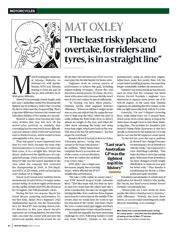So let’s make the differences more tangible by converting race times into percentages. The winner’s race time is 100% – maximum performance – and every rival’s race time is a percentage of that performance. This way you get a better idea of how the different motorcycles compare.
I took a sample of half of last year’s 18 dry races – including races won by Aprilia, Ducati, Yamaha and Suzuki – and converted the race times of the top-finishing rider of each brand into percentages. I tried to choose races where each manufacturer’s best rider finished the race, because he was the one extracting maximum performance from his machine.
The results are astonishing and underline how insanely close MotoGP machinery is at the moment, although ironically that doesn’t always provide great racing. Indeed the proximity of performance is one reason there’s less overtaking now. The law of unintended consequences and all that.
“The bikes are so evenly matched,” affirms KTM’s Brad Binder. “The days of seeing a guy get completely past another rider while braking are gone…”
These are the percentage performance results from last year, bike by bike.
| Manufacturer | Percentage of max. performance |
| Ducati | 99.95% |
| Suzuki | 99.78% |
| Yamaha | 99.69% |
| Aprilia | 99.67% |
| Honda | 99.63% |
| KTM | 99.59% |
No surprise that Ducati’s Desmosedici came out top and what a shame that MotoGP’s second-best machine – Suzuki’s GSX-RR – is no more.

Nothing between them – Honda, Suzuki, Honda, Yamaha and Ducati at Jerez last year
Honda
KTM’s RC16 comes bottom, with an overall race performance just 0.36% worse than the Ducati and 0.04% worse than Honda’s RC213V, largely because of its qualifying issues. The 2022 RC16 couldn’t take as much advantage of the extra side grip offered by a new rear tyre as some of the other bikes, so the few tenths it lost in qualifying pushed it down the grid, costing valuable time in the race.
So when you hear people saying that the KTM or the Yamaha or the Honda are rubbish, they aren’t even close to the reality. All those machines are only fractionally worse than the best.
And when you hear more and more riders say, “I need to work on myself,” this means they acknowledge the similarity in machine performance, so they must find the difference within themselves.





